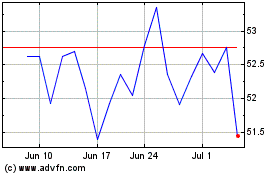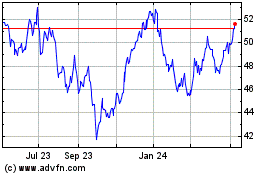MidAmerican Makes Big Bet on Wind Power in Iowa
April 14 2016 - 5:30PM
Dow Jones News
Iowa, which already gets more of its power from wind than any
other U.S. state, will become more reliant on the electricity
source under a $3.6 billion plan announced Thursday by a utility
owned by Warren Buffett's Berkshire Hathaway Inc.
MidAmerican Energy Co. said Thursday that it is planning to
build up to 2,000 additional megawatts of wind turbines with a goal
of generating 85% of its power from wind. The company, based in Des
Moines, will use renewable-energy tax credits that Congress
extended last December to make the project economically feasible,
said MidAmerican Chief Executive Bill Fehrman.
"Because of the tax credits and our ability to deliver these
projects at a low cost, we're setting up our customers for a
low-carbon future," Mr. Fehrman said in an interview. "Whatever
happens with carbon regulations…we will be able to meet those
requirements without additional costs for customers."
Thirty-one percent of the power in Iowa is now generated by
wind, more than in any other state, according to the American Wind
Energy Association, an industry group. MidAmerican's new project
would boost wind's share to 40%, according to the state.
In absolute terms, Iowa is the nation's No. 2 wind-power
producer, with 6,200 megawatts of wind turbines, behind Texas,
according to the group.
MidAmerican is the biggest wind-power producer among regulated
utilities nationwide. The company already operates nearly 3,500
megawatts in Iowa, or about 58% of the power it supplies its
customers in the state. Parent company Berkshire Hathaway is the
third-largest wind-farm owner nationwide, behind NextEra Energy
Inc. and Iberdrola SA.
Coal-fired plants remain the leading source of electricity in
Iowa, providing 53% of power in 2015, while nuclear, natural gas
and hydroelectric power generators produced roughly 16%, according
to the U.S. Energy Department.
The wind industry is important to Iowa's economy, said Iowa Gov.
Terry Branstad, a Republican. Wind-power-equipment makers employ
7,000 people in the state, and thousands of other construction and
technical jobs are created when new wind farms are built, he
said.
Farmers and other landowners hosting wind farms receive lease
payments, and wind-farm operators pay property taxes, which local
governments use for schools and other expenses, he added. Iowa's
relatively low power prices and high renewable-energy quotient have
attracted companies such as Alphabet Inc.'s Google, Microsoft Inc.
and Facebook Inc. to the state, he said.
"Many manufacturers would like to tell their stockholders
they're using green energy," said Mr. Branstad in an interview.
"It's a great marketing tool for us."
Iowa consumers pay about 10 cents a kilowatt-hour for power on
average, compared with 12 cents nationwide, according to the Energy
Department. Large commercial and industrial customers in the state
pay about 5 cents to 8 cents a kilowatt-hour, on average, compared
with 6 cents to 10 cents nationwide.
Wind power fetched about $29 a megawatt-hour, or 2.9 cents a
kilowatt-hour, on average, under long-term contracts signed last
year between power producers and utilities, according to Bloomberg
New Energy Finance.
That compares with an average price of $34.34 a megawatt-hour
for power, primarily from coal and natural-gas plants in the
Midwest, including Iowa, last year, according to Energy Department
data.
Nationwide, wind farms supply nearly 5% of U.S. electricity,
while coal and natural-gas plants each generate 33% of the nation's
power. Nuclear plants produce 20%, hydroelectric dams generate 6%
and solar farms and smaller arrays supply about 1%, according to
the Energy Department.
Write to Cassandra Sweet at cassandra.sweet@wsj.com
(END) Dow Jones Newswires
April 14, 2016 17:15 ET (21:15 GMT)
Copyright (c) 2016 Dow Jones & Company, Inc.
Iberdrola (PK) (USOTC:IBDRY)
Historical Stock Chart
From Mar 2024 to Apr 2024

Iberdrola (PK) (USOTC:IBDRY)
Historical Stock Chart
From Apr 2023 to Apr 2024
